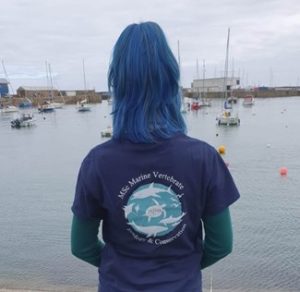As part of the MSc Marine Vertebrate Ecology and Conservation Skills module, students undertake a series of fieldwork sessions within the region of Cornwall, providing them a working knowledge of key practical fieldwork skills and the ability for them to apply the developed skills in future professional settings. Below we hear from MSc Marine Vertebrate Ecology & Conservation student, Lorraine Aldridge, where she discusses her experience throughout the duration of the fieldwork and what it entailed.
Author – Lorraine Aldridge

On-board Marine Discovery, Photo: Lorraine Aldridge
Boat trips – AK Wildlife, Atlantic Diving and Marine Discovery
As part of our fieldwork boat trips, we were split into groups and timetabled for a range of boat trips, ranging from 4 hours to 7 hours, across the course of the two weeks. The trips left from Falmouth with local wildlife watching and scuba diving companies, AK Wildlife Cruises, Atlantic Diving and a third trip from Penzance with Marine Discovery. These boat trips provided us with the opportunity to develop and improve upon our species identification skills, and practice distance sampling strategy, a widely used and powerful method to systematically assess the density and abundance of cetaceans and marine vertebrates at sea.
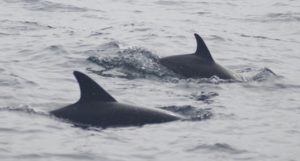
Common Dolphin sighted near Falmouth, Photo: Lorraine Aldridge
I started the first day of the week with AK Wildlife Cruises, meeting at Falmouth Marina, prepared with waterproofs, snacks, binoculars, a camera, notebook, clipboard, pencil, and sea sickness tablets, ready to spot some marine vertebrates! Upon boarding the boats each day, we were split into groups and given a GPS to track a running log for our distance sampling. We recorded effort every 15 minutes and any sightings on a separate recording sheet.
Each boat trip brought something new, a sighting, a location, or a breakthrough in identification ability (for me at least). Some of my highlights of these half-day or full-day boat trips around the Cornish coastline were spotting a puffin, a juvenile porpoise, a huge barrel jellyfish, bow riding common dolphins and improving my seabird identification skills. Every boat trip felt magical, it was a gentle reminder to me about how lucky we are to be studying in such an amazing place for marine life.
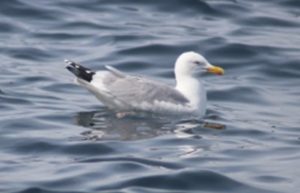
Herring Gull sighted near Falmouth, Photo: Lorraine Aldridge
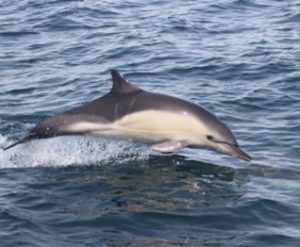
Juvenile Common Dolphin near Penzance, Photo: Lorraine Aldridge
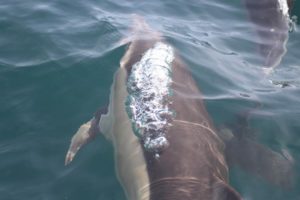
Common Dolphins sighted near Penzance, Photo: Lorraine Aldridge
Another highlight was spotting a minke whale near Penzance, along with a few grey seals making a surprise appearance.
When the weather was less than ideal, we took a detour from the open sea and headed down the Fal River and up the estuary, which brought a new plethora of wildlife to enjoy and explore. Sightings ranged from a peregrine falcon, great northern diver, deer, shelduck, cormorants, terns and seals.
Cornish Seal sanctuary
As part of our field week, we visited the Seal Sanctuary in Gweek, where we were given a guided tour and a private Q&A session. We gained an insight into the process of the rehabilitation of over 70 grey seal pups found within local coastal waters annually.
We learned the journey that rescued seals go through, starting with the specialist seal hospital, then onto rehabilitation in the main sanctuary, alongside how they go about caring for their resident grey and common seals.
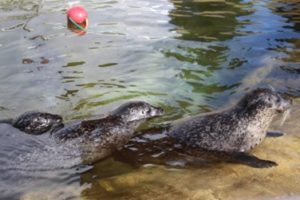
Common Seals, Cornish Seal Sanctuary, Photo: Lorraine Aldridge
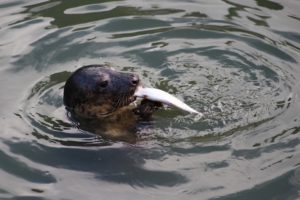
Seal Pup Cornish Seal Sanctuary, Photo: Lorraine Aldridge
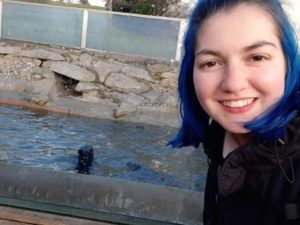
Cornish Seal Sanctuary, Photo: Lorraine Aldridge
Isles of Scilly
On the 6thApril 2022, we embarked on our journey on the Scillonian, from Penzance across to the Isles of Scilly. The crossing over consisted of group distance sampling, (whilst concentrating on not feeling seasick), and took just under 3 hours. With binoculars and range sticks at the ready, we saw lots of manx shearwaters, cormorants, shags, gannets, gulls, auks and fulmar. Once we reached St Marys, the largest island of the archipelago, we boarded a smaller boat across to St Anges, where we would be camping for the following two nights.
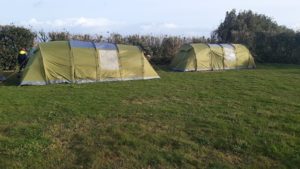
Campsite St Agnes, Photo: Lorraine Aldridge
Once we arrived at the campsite, we had a guided wildlife walk tour of St. Agnes and Gugh by Will Wagstaff, a leading ornithologist and naturalist in the Isles of Scilly. Will showed us the resident lesser black-backed gull nesting colony and we explored the island before setting up our tents. In the evening, Dr Alice Trevail provided a talk on her research on British Indian Ocean Territory (BIOT) Marine Protected Areas for habitat use of non-breeding seabirds in the Western Indian Ocean.
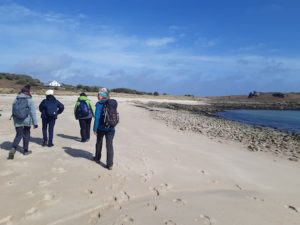
Wildlife guided walk Gugh, Photo: Lorraine Aldridge

Lesser black-backed gull nesting colony, Gugh, Photo: Lorraine Aldridge
The few days following on the Isles of Scilly consisted of a boat trip around the islands, where we tested our sea bird identification skills and saw a range of species such as fulmar, puffins, razorbills, guillemots, grey seals, gannets, a talk from Jaclyn Pearson, biosecurity officer for the RSPB. Community volunteers also joined and we learned about biosecurity on St Agnes (the world’s largest community-led rat removal project) and the community effort to keep St Agnes rat-free.
Brown rats arrived on the islands in the 18th century and as the population of rats grew, they became harmful to the burrow-nesting seabirds, such as the European storm petrels and manx shearwaters. Jaclyn told us how since removing rats, storm petrels have returned to breed on St Agnes and Gugh and manx shearwater fledged chicks for the first time in living memory (back in 2013). 2015 saw the return of breeding European storm petrels, with numbers of both increasing ever since. We then had a tour of the island, meeting community volunteers, whilst also carrying out a section of the rat trap wax checks as we went.
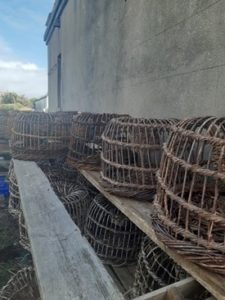
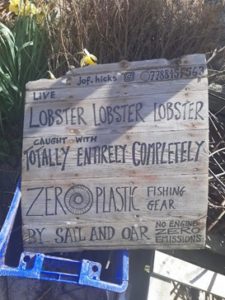
Plastic-free lobster pot fishing, Jof Hicks Isles of Scilly, Photos: Lorraine Aldridge
We were also treated to manx playback from the burrows, which was one of my highlights of the trip.
Lundy Island 12th April 2022
The week following our trip to the Isles of Scilly, and in between a week of boat trips with AK Wildlife, Atlantic Diver and Marine Discovery, we split into two groups across two-day trips to visit Lundy Island, the first designated Marine Conservation Area in the UK.
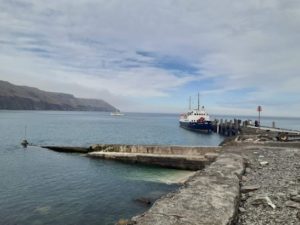
MS Oldenburg, Photo: Lorraine Aldridge
Lundy lies off the coast of North Devon, where the Atlantic Ocean meets the Bristol Channel, and is owned by the National Trust and managed by the Landmark Trust. The two charities have worked together since 1969 to restore and protect all that is cherished and special about Lundy departing from Ilfracombe Harbour on the MS Oldenburg, which took approximately 2 hours each way. The boat trip over was a great way to start homing in our identification skills, spotting a range of sea birds already mentioned in this blog, as well as enjoying some bow-riding dolphins and grey seals.
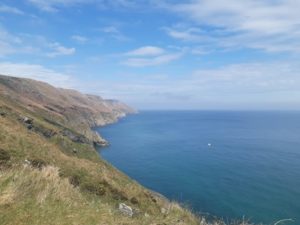
Lundy Island, Photo: Lorraine Aldridge
Once we arrived on the island, we were taken on a guided tour up and across the island to the nesting bird colony where we were lucky enough to see some puffins, lots of gulls, and even a grey phalarope.
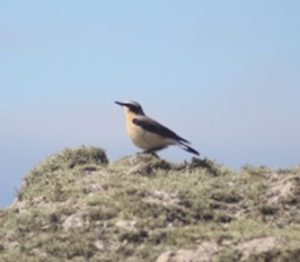
Wheatear, Lundy Island, Photo: Lorraine Aldridge
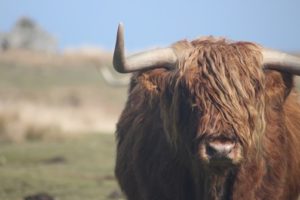
Highland cattle, Lundy Island, Photo: Lorraine Aldridge
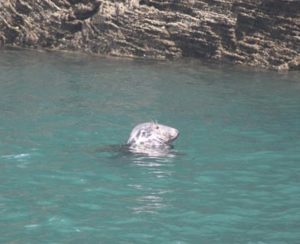
Grey Seal, Lundy Island, Photo: Lorraine Aldridge
Field week
These two weeks of fieldwork allowed us to bond as a course and spend time with each other outside of a lecture setting, network and develop as marine scientists, in an organic fieldwork setting. From carrying out distance sampling, experiencing long days out at sea, sharpening sea bird and marine mammal identification, and developing teamwork/field group communication skills. The two weeks allowed us to develop as marine conservationists and in practical fieldwork environments, which has been a highlight of the degree!
